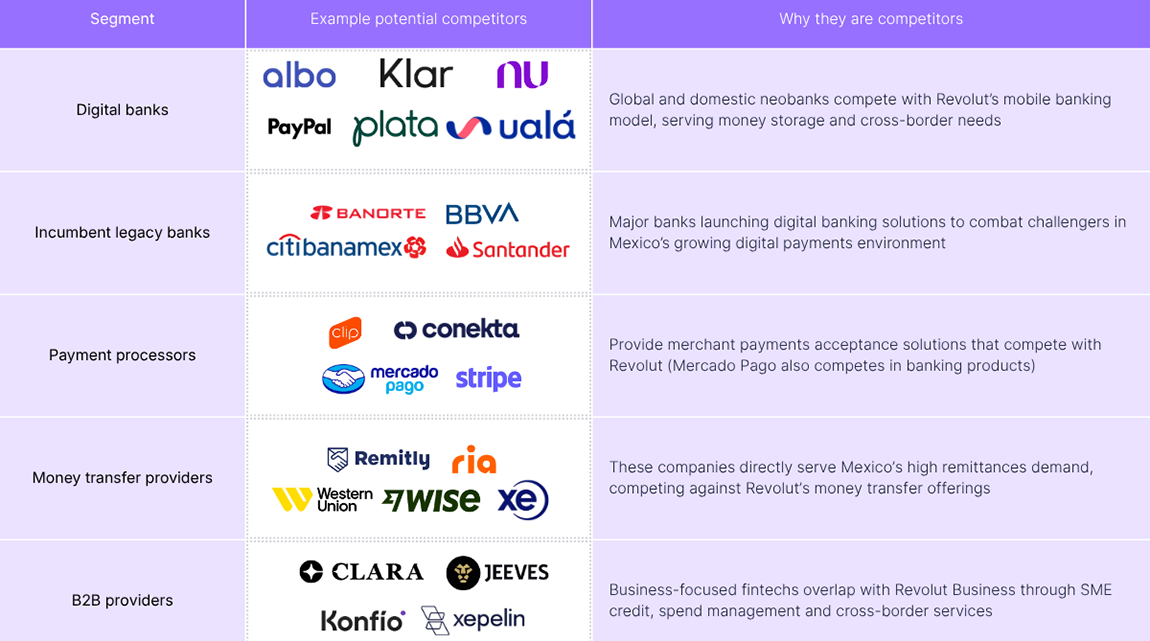Revolut has published its FY 2023 results, showing a company that is increasingly seeing strong performance. We look at how the company has diversified its revenue, where it is finding growth and the role of interest income.
Revolut has published its FY 2023 results, posting record profits and showing a company that has significantly diversified from its crypto-heavy approach of a few years previously.
The results come as the company is making a wider bid to cement itself as a central player in the UK financial services space, including through the establishment of a new global headquarters in the YY London building in Canary Wharf – a centrepiece of the city’s financial hub. It also follows the announcement that the company is seeking a $40bn valuation in a share sale – up from a $33bn valuation in 2021.
However, the results also arrive as Revolut is still looking to secure a UK banking licence, having first applied in 2021, impairing its ability to to offer lending products in the country. This has been marred by delays to some previous accounts – it filed its 2021 results in March 2023 – as well as issues with its share structure, which included shares with preferential rights. The company was forced to collapse multiple classes of shares in order to comply with Bank of England requirements.
Revolut CEO Nikolay Storonsky told CNBC last week that the company would “hopefully” secure the licence “sooner or later” and that regulators were “still working on it”. The company was granted a full EU banking licence in 2021 and at the time said it hoped to secure the UK equivalent in 2022. This means it is a fully licenced bank in 30 of the 38 countries it covers.
Meanwhile, Revolut is still considering where it will make its public debut, with Chair Martin Gilbert telling the Financial Times that an IPO was still at least a year away, and that the company would “keep an open mind” about whether to list in London or not.
Given the questions that remain over Revolut’s future, how has it performed in its 2023 results and where has its growth come from? We dig into the details to find out.
Revolut’s FY 2023 results
At the top line, this has been a strong year for Revolut. Revenue has increased 95% to £1.8bn, while gross profit has increased 114% to £1.4bn, providing a gross margin of 76%, up from 2022’s 70%.
Operating profit, meanwhile, has climbed from -£25m to £438m, providing by far the strongest profit performance for the company to-date. It also posted total comprehensive income of £342m, which was up significantly on 2022’s £12m.
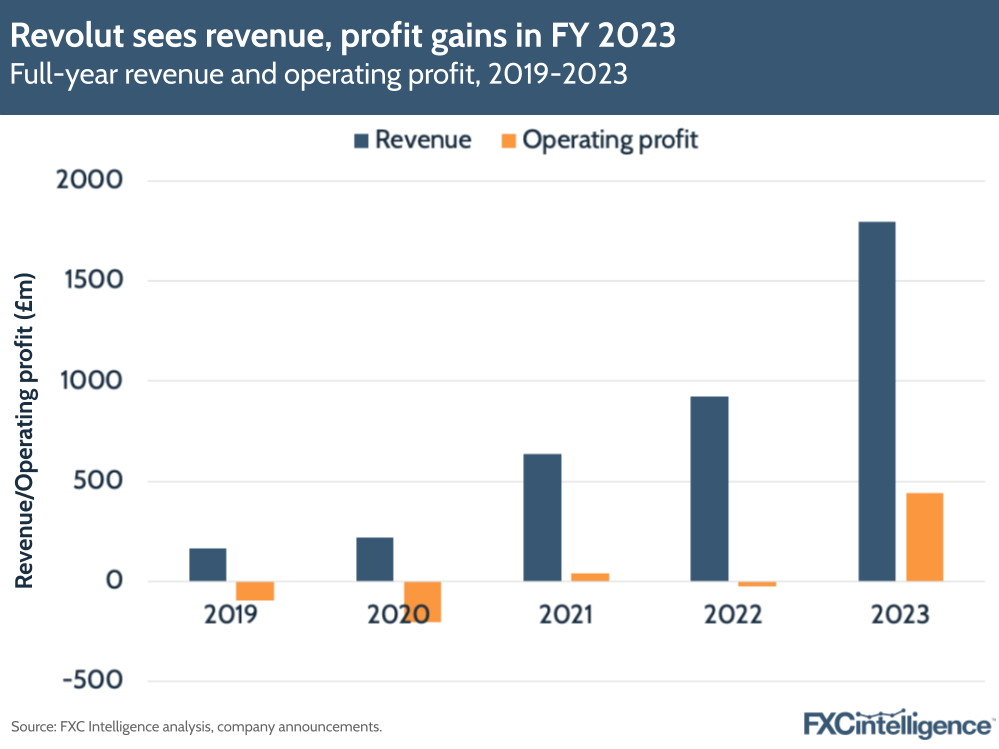
Crucially, these figures see the company recover from a slightly more muted performance in 2022, when revenue grew by 45% YoY and operating profit dropped from £40m to -£25m.
This is also reflected in the company’s revenue per employee. While Revolut has been consistently increasing headcount, passing 6,000 in 2022 and reaching 8,152 in 2023, its revenue per employee dropped by around 28% in 2022; in 2023 however, this climbed 43% to £220,546 – its highest to-date.
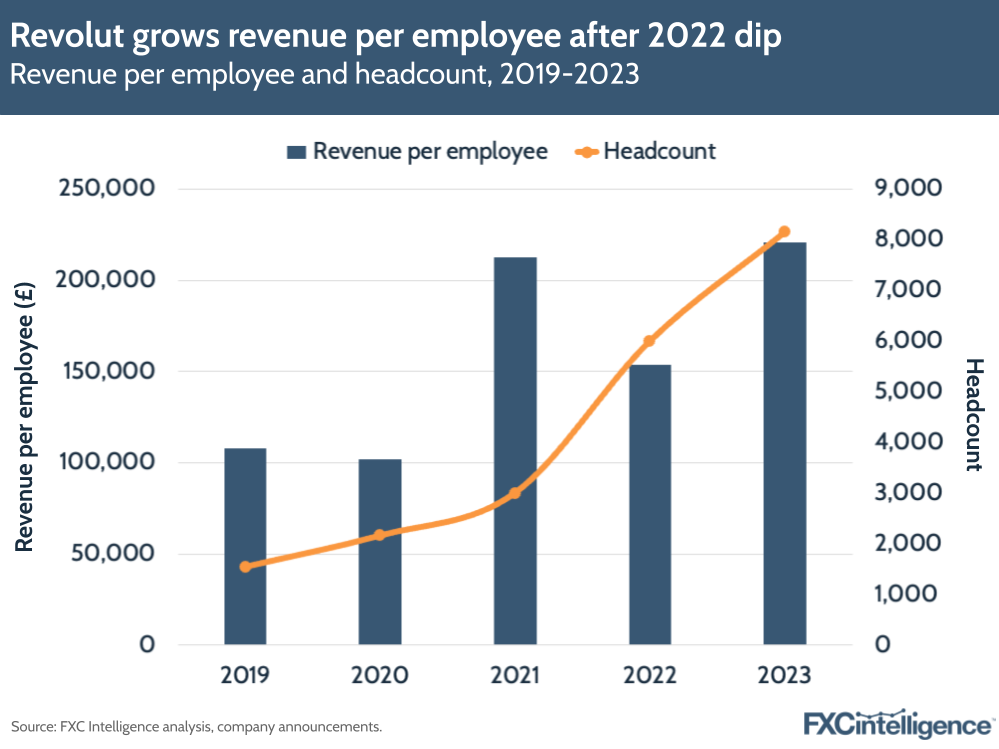
Revolut diversifies revenue in FY 2023
The surge in top-line results in 2021 and the subsequent dip in 2022 were the result of the level of contribution from crypto, which underwent a bubble burst during this period. This resulted in crypto’s revenue contribution dropping from 30-35% for Revolut in 2021 to less than 5% in 2022.
Crypto has seen a return in 2023 and Revolut has continued to expand its offering in this area, with the number of tradeable tokens offered climbing from 90 in 2022 to the current 175+. The company also launched a standalone trading platform, Revolut X, in May 2024.
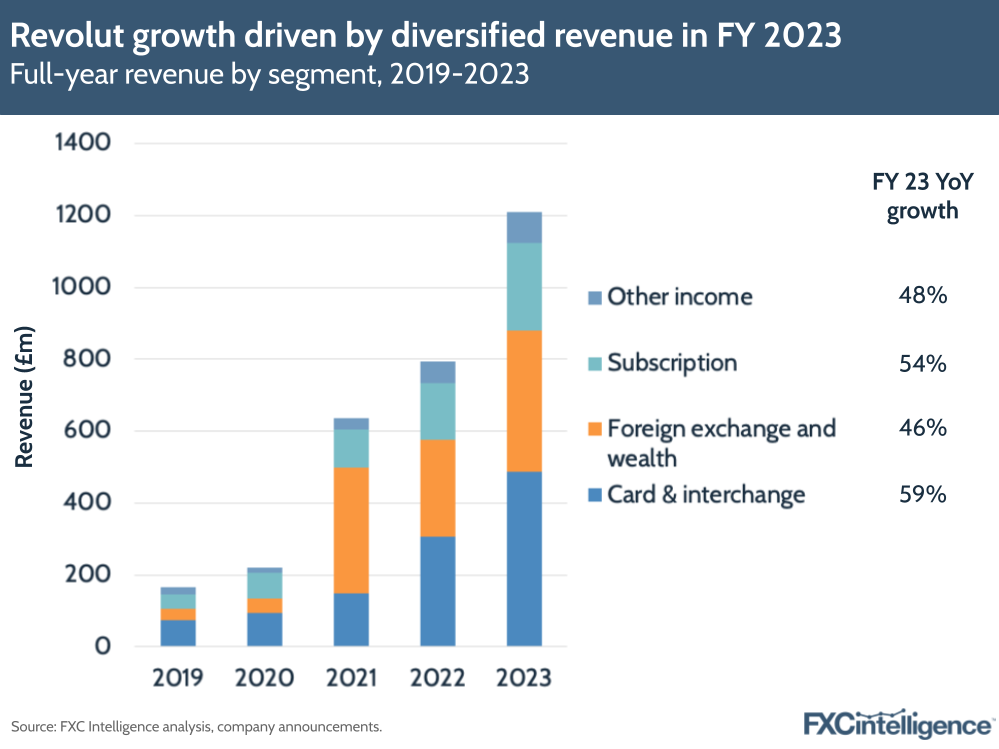
However, while the company does not explicitly break out crypto results, it is clear that crypto has not been solely responsible for the company’s 2023 performance. Cryptocurrency trading forms part of the foreign exchange and wealth market, which in 2021 accounted for 55% of the company’s revenue, dropping to 29% in 2022. In 2023, it accounted for just 22% of revenue.
This isn’t to say this segment hasn’t seen growth – it climbed 46% YoY in 2023 following a -23% drop in 2022 – but its growth has been outpaced by other increasingly strong segments for the company. Card & interchange was the company’s fastest growing category in 2023, increasing 59%, and is also now its largest category, at 27% of revenue.
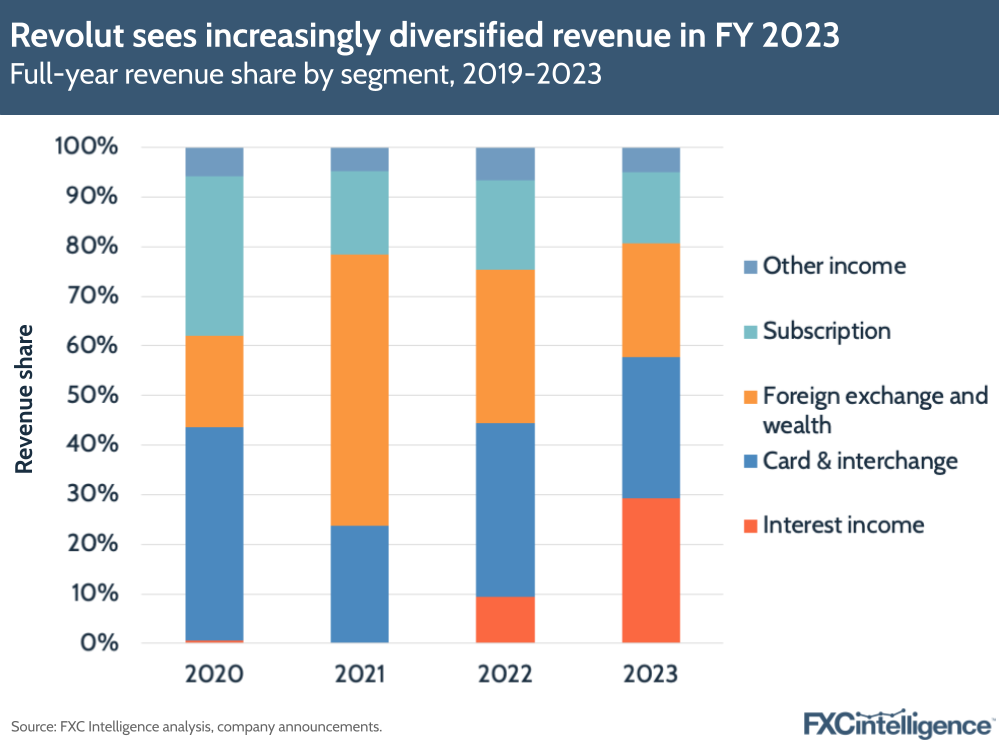
Subscription, which accounts for 14% of revenue, also saw a 54% YoY increase. This reflects the increasingly broad range of features Revolut offers and the fact that the company is seeing success by increasing the number of products it offers to individual customers, as well as adding new ones.
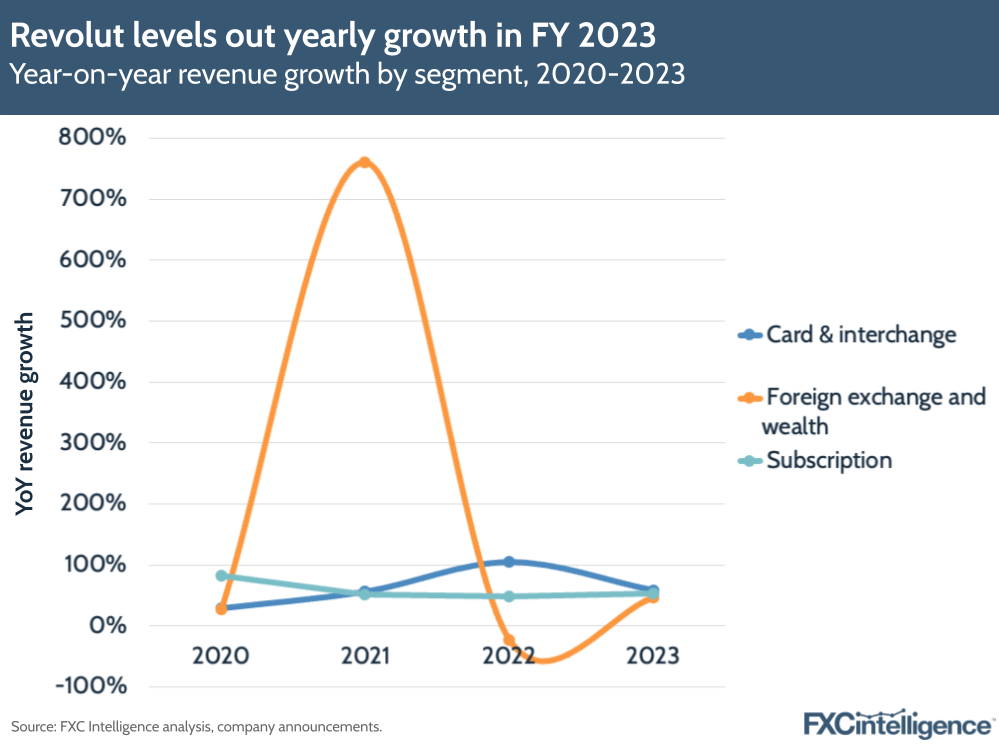
Inside Revolut’s interest income growth
2023 also saw a very notable increase in interest income. This is the interest earned from interest rates on credit cards and loan agreements with customers – which the company can provide in its European markets where it has a banking licence – as well as cash and cash equivalents that it holds, which will include customer balances.
In 2023, Revolut’s interest income increased from £83m to £500m – a 502% increase. This also saw it jump from a 9% share of all revenue in 2022 to a 28% share in 2023, meaning it is now the single biggest contributor to the company’s revenue line.
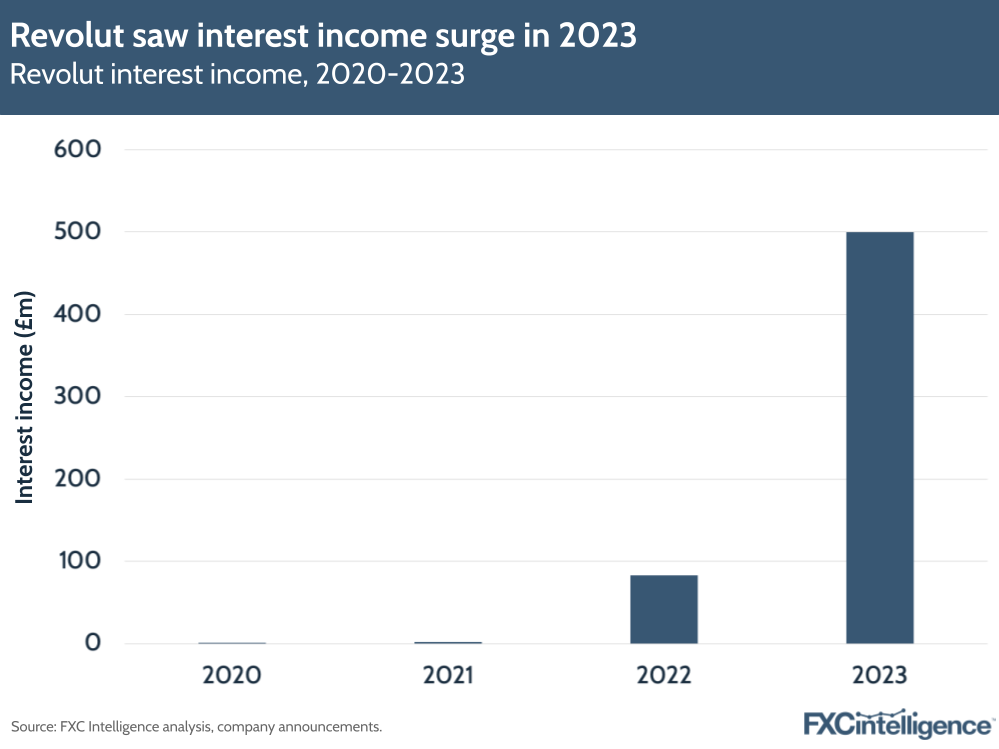
Crucially, while interest earned from customer loans and advances did see a significant increase between 2022 and 2023, growing 367% YoY, this was outmatched by interest the company earned on treasury investments.
However, all segments were significantly outpaced by the increase in interest Revolut made on cash and bank balances – i.e. the money it made from customer balances held in its wallets and bank accounts. Here, the company saw an 898% increase in interest income, with this category accounting for more than three-quarters of all interest income.
Revolut is not the only company to report a rise in revenue from interest income earned from customer balances (others include Payoneer), however its sharp increase in 2023 is likely the combined result of several factors. Firstly, Revolut saw customer balances increase from £13.2bn in 2022 to £18.2bn in 2023, but also benefited from high interest rates in the year. Significantly, however, in regions where it does not have a banking licence, it will have also been restricted in its ability to pass this on to its customers in the form of interest on their deposits.
This surge is therefore beneficial for the company but may not translate into sustainable growth, particularly if the interest rate environment changes in the future.
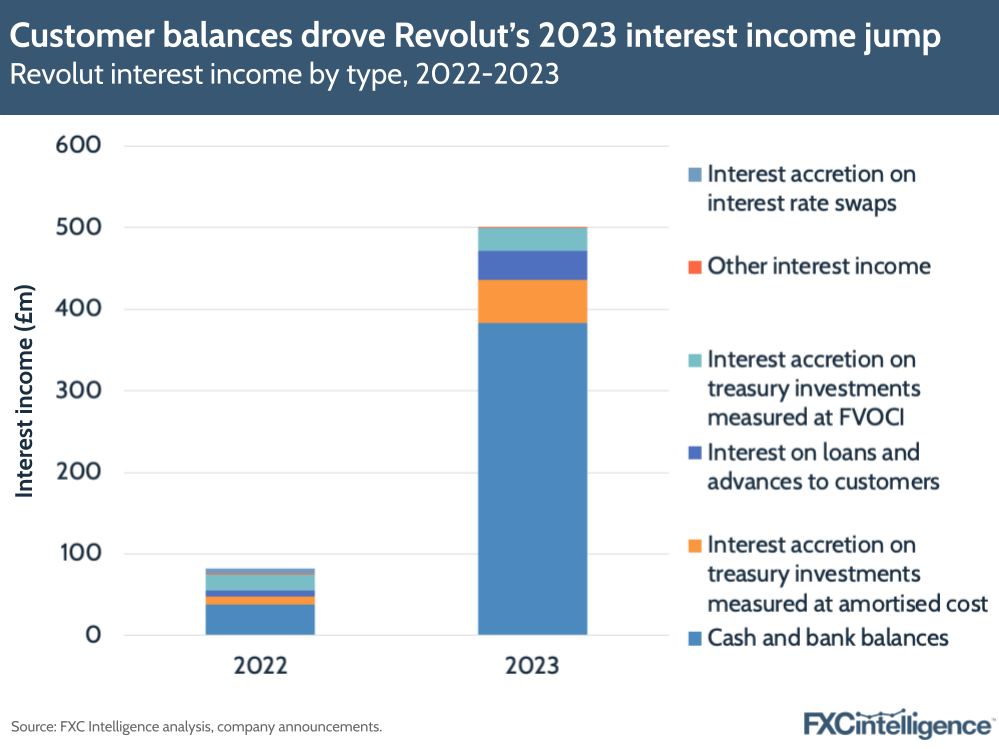
Regional growth highlights future growth potential
Looking regionally, while the UK began as Revolut’s core market, Europe has been its dominant area since 2020, and in 2023 Europe saw its share slightly grow to account for 68.4% of revenue, compared to 2022’s 67.7%. By contrast, the UK has reduced slightly in terms of overall share, from 29.9% in 2022 to 29.0% in 2023.
Both regions have performed strongly, however, with the UK seeing 48% YoY growth compared to Europe’s 54%. Europe’s increased performance over the UK is likely the result of the relative size of the market, as well as the fact the region has a full banking licence, meaning that Revolut is able to offer products it cannot provide in the UK at present.
However, the fact that the UK still accounts for almost half of the revenue achieved by Europe speaks to the level of growth still to be achieved in the much larger European market.
The Rest of World segment, which remains small at 2.6% of all revenue, saw the strongest growth at 69.1%, with the company still in the early stages of tapping into this market. While it launched in Australia and Singapore in 2019 and the US and Japan in 2020, in 2023 the company expanded to both Brazil and New Zealand, as well as adding its Business service in Australia.

Customer growth and 2024 targets
Finally, Revolut reported a 45% increase in personal customers to 38 million, the third year in a row where personal customers have grown at above 40% YoY. The company also reported that Revolut Business was adding 20,000 SME customers each month by the end of 2023, although it has not provided direct growth figures or overall numbers for its business segment for the year.
Notably, Revolut is expecting to continue to see its personal customers grow in 2024 and is projecting 50+ million customers by the end of the year. At 50 million, this would translate into a 32% YoY growth rate, suggesting a slight slowdown, but at around 55 million it would match its 2023 growth rate. The company has reported that it reached 45 million customers by the end of H1 2024.
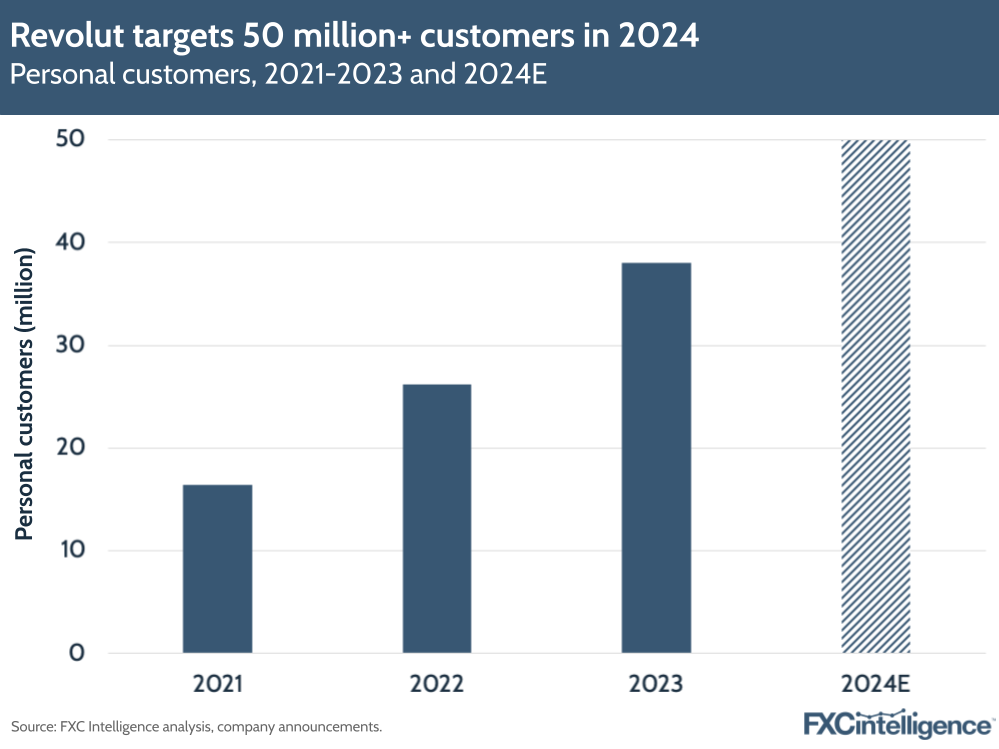
The company has not provided any revenue projections for 2024, although has highlighted that it has already launched several new products and features that are aimed at contributing to future growth, including eSIMs and its loyalty programme RevPoints.
Given the company’s 2023 results, 2024 is likely to show further growth across the company’s main segments – however whether interest income will continue to be as strong a share remains to be seen.


